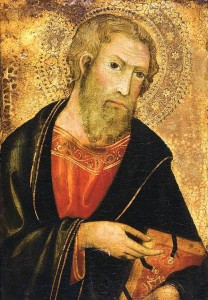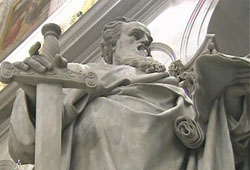 At Solemn Vespers for the Solemnity of the Conversion of Saint Paul this evening, Pope Francis preached the following homily at the Basilica of St Paul outside the Walls.
At Solemn Vespers for the Solemnity of the Conversion of Saint Paul this evening, Pope Francis preached the following homily at the Basilica of St Paul outside the Walls.
“Has Christ been divided?” (1 Cor 1:13). The urgent appeal which Saint Paul makes at the beginning of his First Letter to the Corinthians, and which has been proclaimed at this evening’s liturgy, was chosen by a group of our fellow Christians in Canada as the theme for our meditation during this year’s Week of Prayer.
The Apostle was grieved to learn that the Christians of Corinth had split into different factions. Some claimed: “I belong to Paul”; while others claimed: “I belong to Apollos” or “I belong to Cephas”, and others yet claimed: “I belong to Christ” (cf. v. 12). Paul could not even praise those who claimed to belong to Christ, since they were using the name of the one Savior to set themselves apart from their other brothers and sisters within the community. In other words, the particular experience of each individual, or an attachment to certain significant persons in the community, had become a yardstick for judging the faith of others.
Amid this divisiveness, Paul appeals to the Christians of Corinth “by the name of our Lord Jesus Christ” to be in agreement, so that divisions will not reign among them, but rather a perfect union of mind and purpose (cf. v. 10). The communion for which the Apostle pleads, however, cannot be the fruit of human strategies. Perfect union among brothers and sisters can only come from looking to the mind and heart of Christ Jesus (cf. Phil 2:5). This evening, as we gather here in prayer, may we realize that Christ, who cannot be divided, wants to draw us to himself, to the sentiments of his heart, to his complete and confident surrender into the hands of the Father, to his radical self-emptying for love of humanity. Christ alone can be the principle, the cause and the driving force behind our unity.
As we find ourselves in his presence, we realize all the more that we may not regard divisions in the Church as something natural, inevitable in any form of human association. Our divisions wound Christ’s body, they impair the witness which we are called to give to him before the world. The Second Vatican Council’s Decree on Ecumenism, appealing to the text of Saint Paul which we have reflected on, significantly states: “Christ the Lord founded one Church and one Church only. However, many Christian communities present themselves to people as the true inheritance of Jesus Christ; all indeed profess to be followers of the Lord but they differ in outlook and go their different ways, as if Christ were divided”. And the Council continues: “Such division openly contradicts the will of Christ, scandalizes the world, and damages the sacred cause of preaching the Gospel to every creature” (Unitatis Redintegratio, 1).
Christ, dear friends, cannot be divided! This conviction must sustain and encourage us to persevere with humility and trust on the way to the restoration of full visible unity among all believers in Christ. Tonight I think of the work of two great Popes: Blessed John XXIII and Blessed John Paul II. In the course of their own lives, both came to realize the urgency of the cause of unity and, once elected to the See of Peter, they guided the entire Catholic flock decisively on the paths of ecumenism. Pope John blazed new trails which earlier would have been almost unthinkable. Pope John Paul held up ecumenical dialogue as an ordinary and indispensable aspect of the life of each Particular Church. With them, I think too of Pope Paul VI, another great promoter of dialogue; in these very days we are commemorating the fiftieth anniversary of his historic embrace with the Patriarch Athenagoras of Constantinople.
The work of these, my predecessors, enabled ecumenical dialogue to become an essential dimension of the ministry of the Bishop of Rome, so that today the Petrine ministry cannot be fully understood without this openness to dialogue with all believers in Christ. We can say also that the journey of ecumenism has allowed us to come to a deeper understanding of the ministry of the Successor of Peter, and we must be confident that it will continue to do so in the future. As we look with gratitude to the progress which the Lord has enabled us to make, and without ignoring the difficulties which ecumenical dialogue is presently experiencing, let us all pray that we may put on the mind of Christ and thus progress towards the unity which he wills.
In this climate of prayer for the gift of unity, I address a cordial and fraternal greeting to His Eminence Metropolitan Gennadios, the representative of the Ecumenical Patriarch, and to His Grace David Moxon, the personal representative in Rome of the Archbishop of Canterbury, and to all the representatives of the various Churches and Ecclesial Communities gathered here this evening.
Dear brothers and sisters, let us ask the Lord Jesus, who has made us living members of his body, to keep us deeply united to him, to help us overcome our conflicts, our divisions and our self-seeking, and to be united to one another by one force, by the power of love which the Holy Spirit pours into our hearts (cf. Rom 5:5). Amen.
 Today, on the Feast of the Conversion of St. Paul, I hear you can now pre-order a new book co-authored by Brant Pitre, Michael Barber and John Kincaid. Paul, a New Covenant Jew: Rethinking Pauline Theology to be published by Eerdmans in August 2019! Michael Gorman wrote the Foreword to the book.
Today, on the Feast of the Conversion of St. Paul, I hear you can now pre-order a new book co-authored by Brant Pitre, Michael Barber and John Kincaid. Paul, a New Covenant Jew: Rethinking Pauline Theology to be published by Eerdmans in August 2019! Michael Gorman wrote the Foreword to the book.






